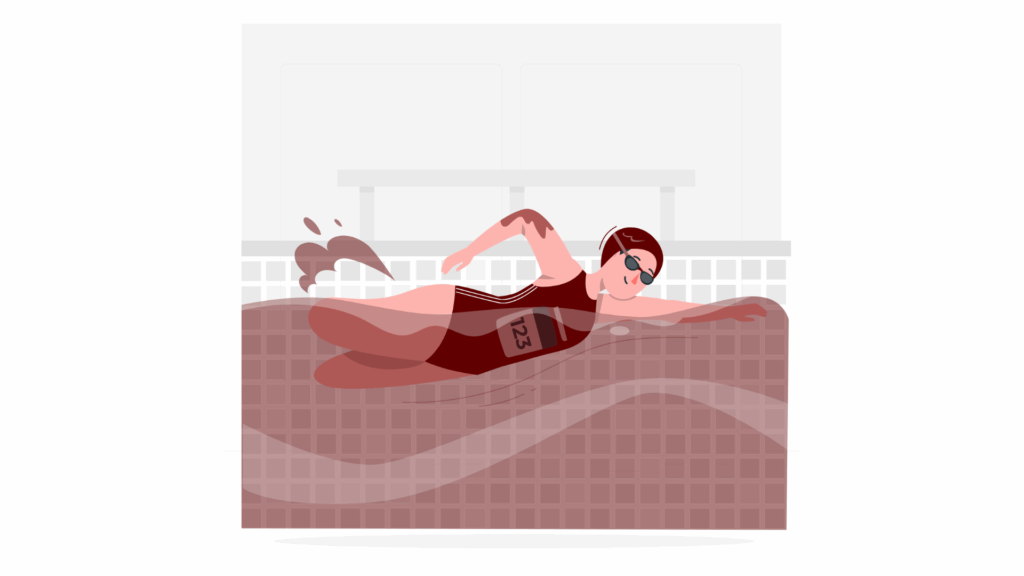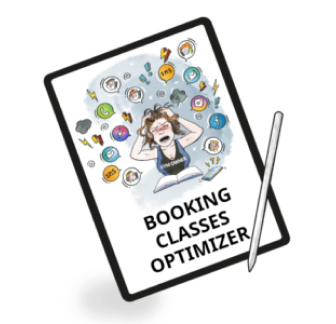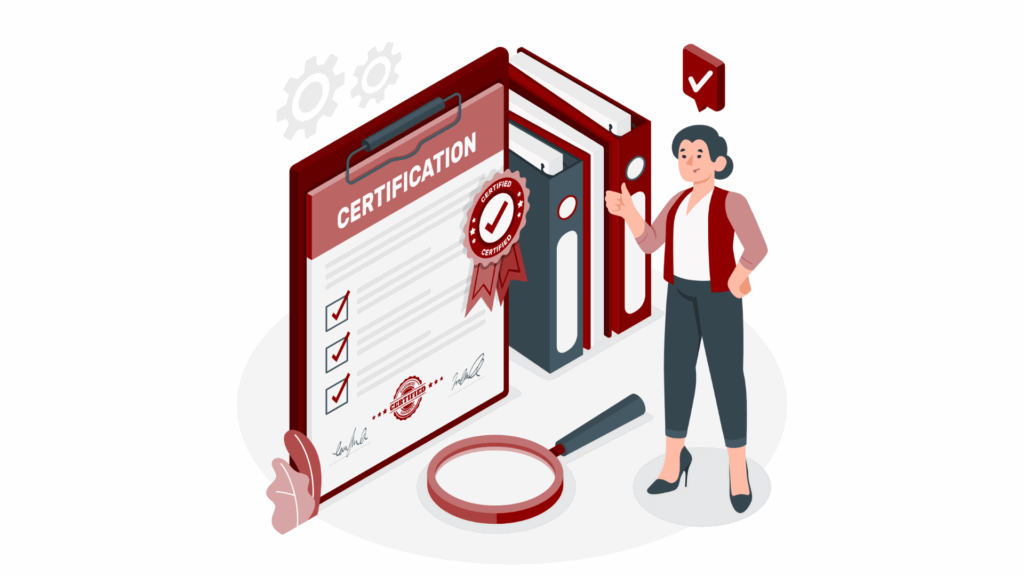For many, swimming is more than just a sport—it’s a vital life skill. As a swim instructor, you hold the power to change lives, instilling confidence and a love for the water while teaching crucial safety lessons.
This career path is incredibly rewarding, blending passion with purpose and offering a unique opportunity to positively impact your community. Whether you’re a seasoned swimmer looking to share your skills or someone passionate about water safety, this comprehensive, step-by-step guide will provide you with a clear roadmap to becoming a certified swim instructor in 2025.
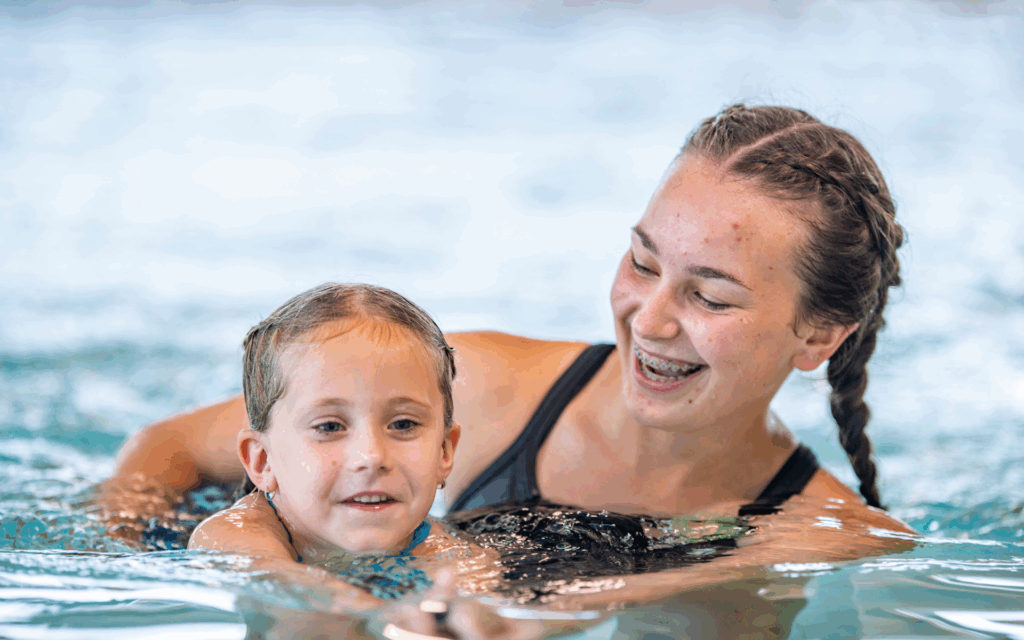
This step-by-step guide will walk you through everything you need to know about how to become a swim instructor in 2025 – from the basic requirements and top certifications to building experience and launching your career. Whether you’re just diving in or ready to turn your passion into a profession, this roadmap will help you make a splash in the world of aquatic instruction.
Key Takeaways
- Strong Swimming Skills Are Just the Beginning - to become a successful swim instructor, you need more than just technique—you must enjoy teaching, communicate clearly, and prioritize safety at all times.
- Choose the Right Certification Program - opt for a reputable certification like Red Cross WSI, YMCA Swim Instructor, or ASCA, depending on your location and goals. In 2025, many offer flexible online and hybrid options.
- Gain Practical Experience - start by assisting experienced instructors or volunteering at local pools. Teaching various age groups builds confidence and helps you develop your own instructional style.
- Explore a Range of Career Options - swim instructors can work in schools, fitness clubs, summer camps, and resorts—or build their own freelance business offering mobile or private lessons.
- Stay Certified and Keep Learning - recertify regularly and invest in continuing education to stay current with best practices, adaptive techniques, and new trends in aquatic education.
Why Become a Swim Instructor in 2025?
In 2025, becoming a swim instructor offers a unique blend of purpose, flexibility, and opportunity. Becoming a water safety instructor in 2025 is more than just a job; it’s a mission to save lives and build confidence.
Beyond the rewarding feeling of empowering people to be safe in and around the water, the role also offers a competitive swim instructor salary, which can vary widely depending on location, experience, and the type of lessons offered.
Whether you’re looking for a part-time role or a full-time career, the profession provides flexibility and a chance to make a real difference through the essential skill of teaching swimming.
How Long Does it Take to Become a Swim Instructor?
The time it takes to become a certified swim instructor in 2025 can vary depending on the certification program you choose and your current level of experience, but most people can complete the process in just 2 to 6 weeks.
For example, popular certifications like the American Red Cross Water Safety Instructor (WSI) or YMCA Swim Instructor course typically involve 30–40 hours of combined classroom and in-water training.
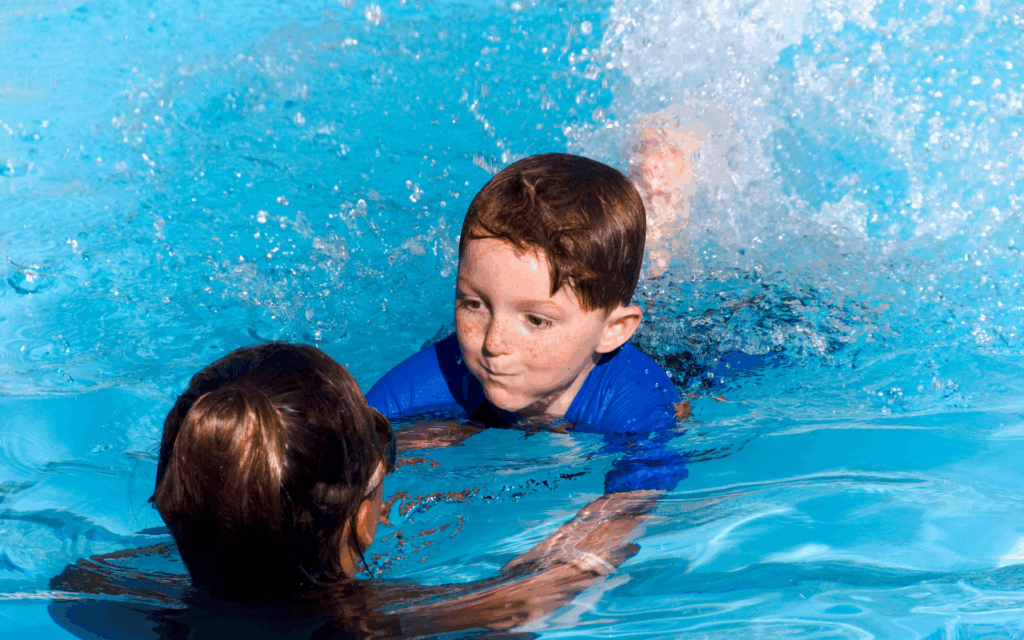
If you also need to obtain CPR, First Aid, or Lifeguard certification—which many employers require—you may need an additional 1 to 2 days of training.
Some programs now offer hybrid formats, allowing you to complete theory modules online at your own pace and finish the practical skills in a few intensive sessions. While it’s a relatively short journey, becoming a swim instructor requires focus, commitment, and a passion for teaching—qualities that make the certification both achievable and meaningful.
What Certification Do You Need to be a Swim Instructor?
If you love being in the water and want to make a meaningful impact on others, becoming a certified swim instructor can open the door to a rewarding, flexible career.
Whether you’re working at community centers, public pools, or offering private swim lessons, having the right certification is essential. It proves that you’re trained not just in swimming techniques, but also in aquatic safety, emergency response, and lesson planning for different age groups and skill levels.
How to Become a Certified Swim Instructor?
In 2025, there are many pathways to becoming a certified instructor, including:
- online courses,
- in-person training,
- hybrid models that combine the two.
Programs offered by organizations like the American Red Cross, YMCA, Swim Lessons University, or the Aquatic Training Academy allow you to complete the process in just a few weeks, depending on the certification route and prior experience.
During the course, you will learn essential swimming techniques, rescue methods, and the principles of lesson planning. A key component is understanding the right techniques to teach a wide range of students, from children to adults.
Upon successful completion of the training and a final exam, you will receive a certification valid for a specific certification period, which you’ll need to renew to continue your work as a certified instructor. This foundation is what allows swim instructors to work effectively and safely.
How to Become a Certified Infant Swim Instructor?
Teaching infants to swim is a specialized and deeply rewarding field that requires additional training. While a general certification provides a strong base, becoming a certified infant swim instructor means you must complete courses specifically focused on the unique needs of this age group.
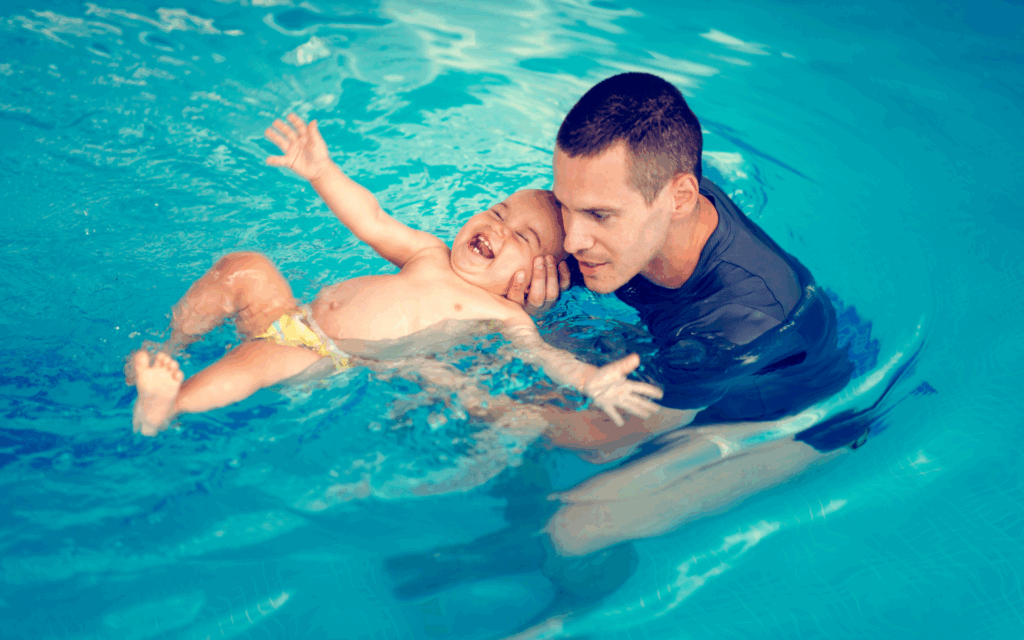
Organizations like Swim Lessons University and the Aquatic Training Academy offer dedicated programs that go beyond basic techniques. These specialized courses focus on gentle teaching methods, infant developmental stages, and parent communication, ensuring you can create a positive and safe experience for both the child and their guardian.
How to Become a Certified Baby Swim Instructor?
How to become a baby swim instructor? For many, the terms “infant” and “baby” are used interchangeably, and the certification process is similar.
To become a certified baby or toddlers swim instructor, you’ll typically need to first hold a general swim instructor certification.
You then enroll in a specialized course that provides in-depth knowledge of teaching children from birth to toddlerhood. The curriculum for these courses covers specific skills like water acclimation, floating, and submersions in a controlled and safe environment.
The training emphasizes creating a fun and trusting atmosphere, often incorporating songs and games, to ensure the children’s first experiences in the pool area are positive and joyful.
How to Become a Swim Instructor? Step-by-step Guide
Becoming a certified water safety instructor is a fulfilling career path that combines your passion for swimming with a commitment to water safety. This step-by-step guide will walk you through the essential stages of becoming a qualified professional, from the initial self-assessment to finding a job and continuously growing in your role.
1. Assess If Swim Instruction Is Right for You
Before you embark on the path to certification, it’s important to assess if being a swim instructor aligns with your personality and goals. The job is about more than just knowing how to swim; it’s about connecting with people.
You need to have the patience to work with students who may be afraid of the water and the creativity to make teaching swim lessons engaging and fun.

The role means giving your students the confidence and ability to navigate the water safely. You must also be a strong communicator, able to explain complex swimming techniques clearly and effectively to people of all ages, from toddlers to adults.
2. Meet the Basic Requirements for Most Swim Instructors
Most certifying organizations have a few core prerequisites you must meet before you can enroll in a program. While these can vary slightly, you’ll generally need to be at least 15 or 16 years old.

You must also demonstrate strong personal swimming skills, often by completing a pre-test that requires you to swim a certain distance using various strokes, such as the front crawl, backstroke, and breaststroke. This foundational skill set is crucial for your water safety and the safety of your students.
3. Choose the Right Swim Instructor Certification
Selecting the right certification is one of the most important decisions on your journey. Top programs in 2025 include the Red Cross Water Safety Instructor (WSI), YMCA Swim Instructor, and Swim Lessons University.
These courses provide a mix of theory and practical in person training, along with online modules for flexibility. Your choice should depend on where you plan to work, your target audience, and whether you want a general or basic swim instructor certification. That’s the same as tennis coach certification or personal trainer!
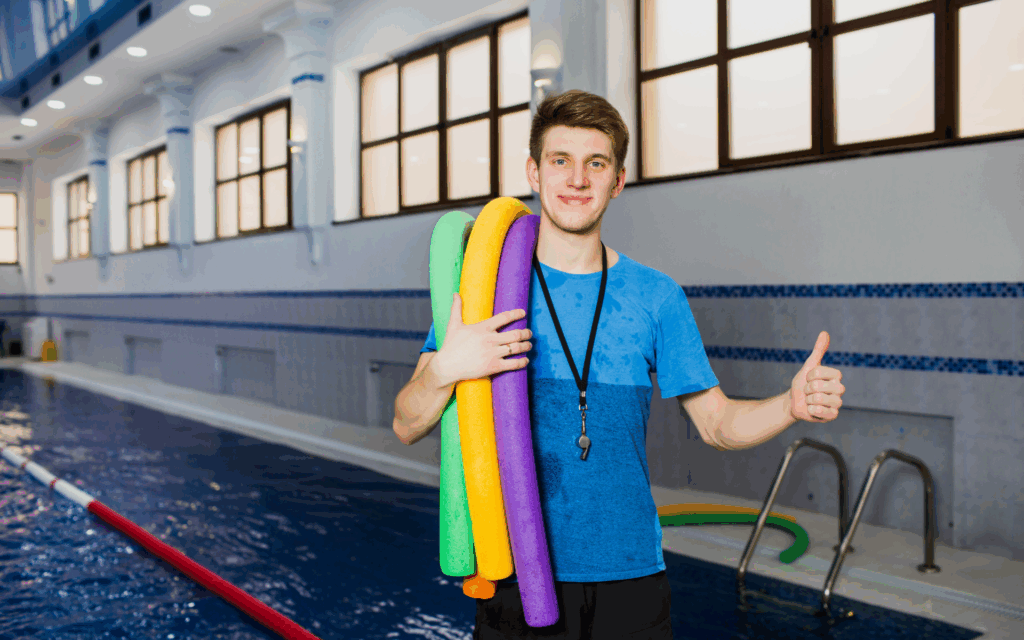
If you’re planning to offer private sessions, make sure your certification is recognized by local authorities or insurance providers.
4. Get CPR Certification, First Aid, and Lifeguard Training
Safety is the foundation of every swim lesson, which is why most employers and certifying bodies require CPR, First Aid, and sometimes lifeguard training.
These credentials prepare you to handle emergencies such as near-drownings, slips, or medical incidents. Many programs offer these certifications as part of bundled training, reducing the time and cost.
Being fully equipped in water safety and emergency response doesn’t just make you a better instructor—it gives parents and students peace of mind, especially when you’re teaching young children or those with special needs.
5. Complete Your Instructor Course Training
Once you’ve chosen your program, it’s time to complete the training. These courses typically last for a few weeks and combine classroom learning with practical application in a pool. You’ll learn how to develop lesson planning, manage a class, and teach learn to swim skills effectively.
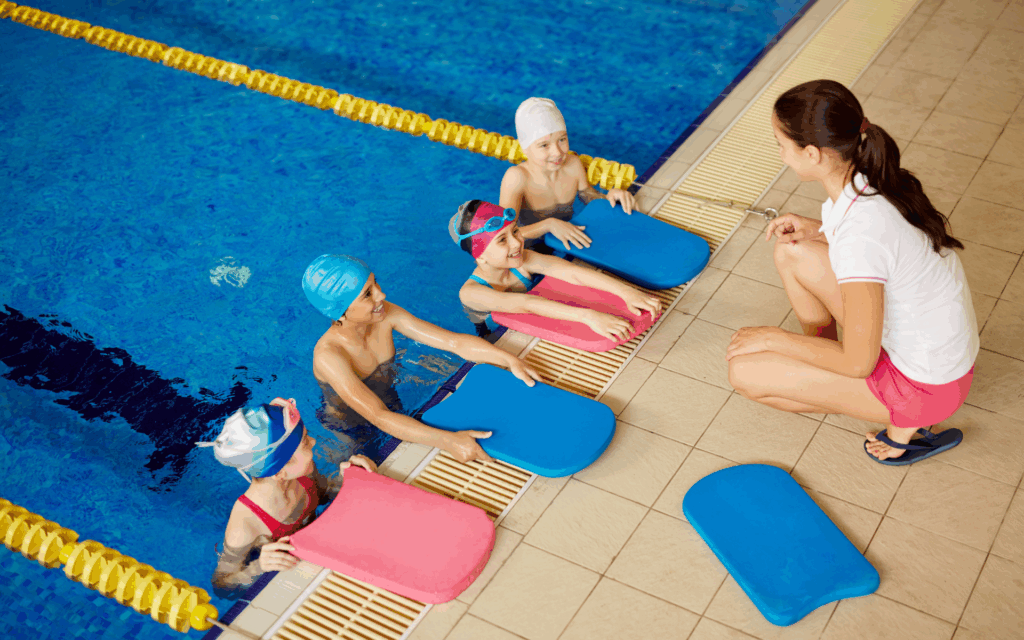
The hands-on portion is crucial, as you’ll practice teaching swimming to a variety of students, often under the guidance of a certified instructor trainer. This practical experience is where you’ll begin to build your confidence and refine your teaching style.
6. Gain Experience and Build Confidence
After completing your training, the next step is to gain real-world experience. Many new instructors start by working as an assistant to a veteran instructor at a public pool or a swim school.
You can also begin teaching your own private swim lessons to friends, family, or people in your neighborhood. This stage is all about applying what you’ve learned and building confidence in your ability to teach and manage a class with gym management software, which will be perfect for your job.
7. Find a Job or Start Your Own Swim Instruction Business
With your certification in hand, you can now explore jobs at community centers, fitness clubs, schools, or start offering private swim lessons. Public pools often seek instructors for seasonal or year-round positions.

If you’re entrepreneurial, you can launch your own mobile swim business, offering lessons at clients’ homes or rental facilities. This path gives you more control over your schedule and income, especially if you cater to specialized audiences like infants, adults, or those learning for the first time.
Whichever route you choose, the demand for quality swim instruction continues to grow in 2025.
8. Stay Certified Swim Instructor and Keep Growing
Your journey doesn’t end with certification—it’s just the beginning. Most credentials require renewal every two to three years, including updated water safety, CPR, and continuing education credits. Think also about workout themes to gain more students! You can even think of starting a sports podcast and becoming a swim influencer!

You can also specialize further by pursuing advanced certifications in infant and toddler instruction, competitive stroke refinement, or teaching individuals with special needs.
Staying current ensures you’re always using the right techniques and upholding the highest safety standards. Whether you’re teaching in community centers, running your own business, or working internationally, ongoing growth will keep your swim instruction career both impactful and exciting.
Tips for Success as a Swim Instructor
Using fitness booking software as a swim instructor – especially one like WodGuru – can be a powerful way to attract and retain more clients, streamline your operations, and enhance the overall professionalism of your swim instruction business.
1. Offer Easy Online Booking and Payments
Today’s clients expect convenience. Gym management software allows swimmers (or parents) to book swim lessons directly through your website or app, choose time slots, and pay online—removing the back-and-forth of scheduling via calls or messages. This seamless experience boosts sign-ups and reduces no-shows.
2. Build Professional Client Profiles
Each swimmer can have a personal profile where you track lesson history, progress, and preferences. Parents love seeing their child’s growth. This also allows you to segment your clients by level (beginners, advanced, toddlers, special needs), so you can tailor your marketing and lesson planning accordingly thanks to gym marketing software.
3. Use Automated Reminders and Communication
Send automated reminders before each class, updates about pool closures, or personalized messages like “Congrats on completing your 10th lesson!” Using email and SMS integrations in gym CRM software keeps you in touch without taking up your time—and helps you maintain high retention.
4. Showcase Availability and Services Publicly
Most gym management tools allow you to display your schedule and services on a landing page. You can list swim levels (toddler, baby, adult, special needs), lesson formats (1-on-1, group, sibling lessons), and even add testimonials. This increases trust and visibility for new clients browsing online.
5. Track Performance and Optimize Your Business
Using reports, you can identify your most popular time slots, top-selling packages, or client retention trends. This helps you optimize your schedule, pricing, and even lesson format to better meet demand and increase profitability.
FAQ
A swim instructor is typically referred to as a swim instructor or water safety instructor (WSI), especially if they are certified by programs like the American Red Cross.
This swim instructor position involves teaching individuals of all ages how to swim safely and confidently while promoting aquatic safety at all times. In some settings, especially at a swim school, they may also be called “aquatic instructors” or “learn-to-swim specialists,” depending on their certification and the type of lessons they offer.
While both roles work in the water, a swim instructor focuses on teaching basic skills, water confidence, and aquatic safety to beginners, children, or adults learning to swim. In contrast, a swim coach trains competitive swimmers to improve performance, technique, speed, and endurance.
Swim instructors typically work in a swim school or community pool setting, offering structured swim lessons for all skill levels. Swim coaches are more often found in competitive clubs or school teams, working with experienced swimmers on training programs and competition prep.
Yes, working at a swim school can be a highly rewarding and flexible career, especially for those passionate about teaching and aquatic safety. Many swim schools offer supportive environments, structured lesson plans, and opportunities for growth within the organization.
A swim instructor position at a well-run swim school often comes with benefits like consistent hours, access to training resources, and the chance to make a lasting impact by helping students develop life-saving swimming skills. It’s an especially good fit for those who enjoy working with children and value a job with purpose.

